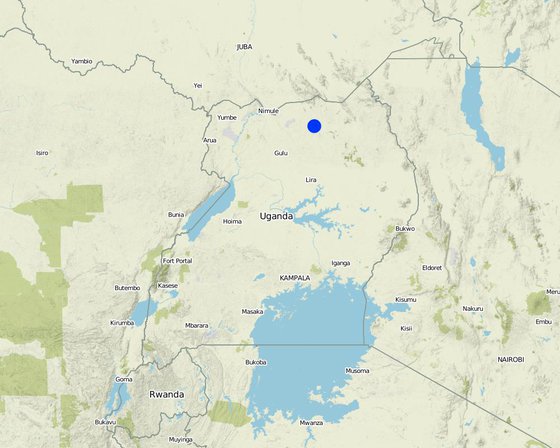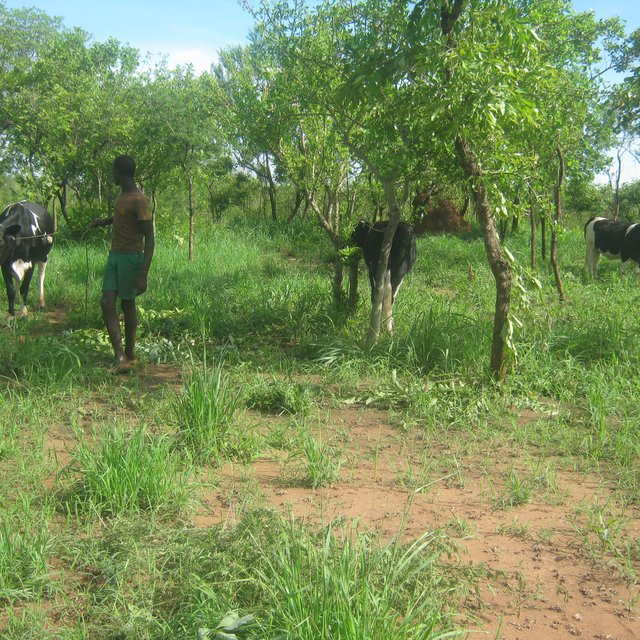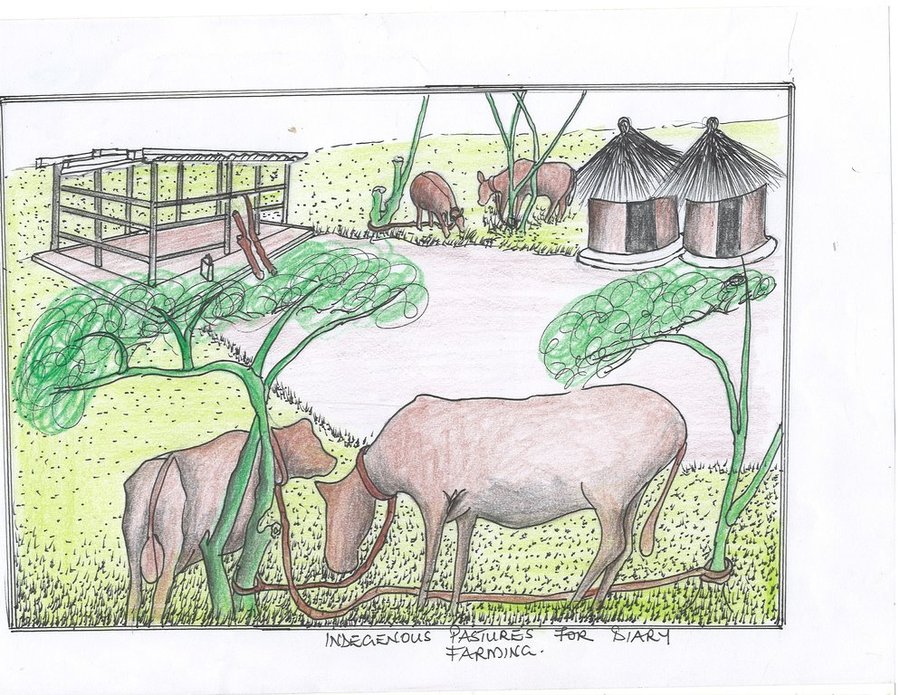



Indigenous pasture-based dairy farming is a balance between managing the pasture and the cows to maximize sustainable profit and promotes conservation of the indigenous grass species which protects the soil against soil erosion and promotes biodiversity. Northern Uganda has tropical savannah climate which receives moderate amount of rainfall ranging from 750-1000mm per annum. This is sometimes characterised by prolonged dry spells which hamper other economic activities like crop production. Therefore, to avoid the climatic shocks, this technology was introduced by the land user to diversify his economic activity other than only relying on crop production. The land user is a typical subsistence farmer whose major source of income depends on dairy farming to support his livelihood.
In this SLM technology, indigenous pastures are conserved for dairy farming. This is due to the existence of savannah grassland vegetation which provide abundant pastures for cattle grazing. This has favoured the rearing of Friesian cow on a flat landscape. A 30x40meters land was highly preserved for this technology. Five (5) cows are kept on this grazing field occupied by natural pasture (elephant grass) that the land user conserve. These grass are nutritious and the cows healthily and freely graze on them during wet and dry season. However, their movement is controlled by the headsman to avoid crop damage.
In order to maintain these grasses, during dry season, the land user creates a fire line around the conserved grazing area. This is to prevent the spread of wild fire from the nearby bush since it is a serious occurrence in the community. The conserved grass dries up during dry season but the dairy cows graze on it and can still produce high volume of milk as during the wet season. A cow produces daily 15 to 20 litters, they are milked twice a day and the milk is taken to town for sale. Soda ash are given to the cows to raise their appetite for pastures and water. Cows are source of milk, which is sold to generate revenue to the farmer for school fees, medications and cow dung is applied in orchard gardens and tree plantations to boost soil fertility.
To establish this technology, One Friesian cow were donated to the land user by a government project and a grazing field was secured which used to be for crop growing. Water tank placed on the grazing field. The grasses were conserved for the cow and shrub trees also protected for shade. With the help of artificial insemination, more calves were produce and today the land user have five cows that freely graze the area although their movement is controlled by the headsman.
This technology conserve grasses which cover the soil from the effects of soil erosion, reduce incidence of wild fire in the area, the shrubs trees are also protected to provide shade to the cows in the grazing field which promotes farmer managed natural regeneration and the grazing cows spread dung around the field which boost soil fertility.
During dry spells pasture growth is retarded and also becomes less nutritious that makes the cows to become skinny and water shortages. Besides, these cows are prone to pests and disease attacks that requires constant monitoring and treatment.

Байршил: Kitgum Municipality, Northern Uganda., Уганда
Дүн шинжилгээнд хамрагдсан технологи нэвтрүүлсэн газрын тоо: нэг байршилд
Технологийн тархалт: газар дээр жигд тархсан (approx. < 0.1 км2 (10 га))
Тусгай хамгаалалттай газар нутагт?:
Хэрэгжилтийн огноо: 2012; <10 жилийн өмнө (саяхны)
Нутагшууллын төрөл







ГТМ хэрэгжихээс өмнөх тоо хэмжээ: low
ГТМ хэрэгжиснээс хойшхи тоо хэмжээ: high
Conserved pastures for cows.
ГТМ хэрэгжихээс өмнөх тоо хэмжээ: low
ГТМ хэрэгжиснээс хойшхи тоо хэмжээ: high
Water is stored in a tank for the animals.
ГТМ хэрэгжихээс өмнөх тоо хэмжээ: low
ГТМ хэрэгжиснээс хойшхи тоо хэмжээ: high
Through sales of milk.
ГТМ хэрэгжихээс өмнөх тоо хэмжээ: highl
ГТМ хэрэгжиснээс хойшхи тоо хэмжээ: low
Has his source of income.
ГТМ хэрэгжихээс өмнөх тоо хэмжээ: low
ГТМ хэрэгжиснээс хойшхи тоо хэмжээ: high
Milk provide food to the land user.
ГТМ хэрэгжихээс өмнөх тоо хэмжээ: low
ГТМ хэрэгжиснээс хойшхи тоо хэмжээ: high
Aware of the importance of soil conservation.
ГТМ хэрэгжихээс өмнөх тоо хэмжээ: low
ГТМ хэрэгжиснээс хойшхи тоо хэмжээ: high
The grazing zone is secure from land disputes.
ГТМ хэрэгжихээс өмнөх тоо хэмжээ: low
ГТМ хэрэгжиснээс хойшхи тоо хэмжээ: high
Grass cover soil from the effects of evaporations retaining more soil moistures.
ГТМ хэрэгжихээс өмнөх тоо хэмжээ: low
ГТМ хэрэгжиснээс хойшхи тоо хэмжээ: high
Grass protects the soil.
ГТМ хэрэгжихээс өмнөх тоо хэмжээ: high
ГТМ хэрэгжиснээс хойшхи тоо хэмжээ: low
Prevents soil erosion.
ГТМ хэрэгжихээс өмнөх тоо хэмжээ: low
ГТМ хэрэгжиснээс хойшхи тоо хэмжээ: high
Plants and trees exists.
ГТМ хэрэгжихээс өмнөх тоо хэмжээ: low
ГТМ хэрэгжиснээс хойшхи тоо хэмжээ: high
Conservation of trees and grass for the animals.
ГТМ хэрэгжихээс өмнөх тоо хэмжээ: high
ГТМ хэрэгжиснээс хойшхи тоо хэмжээ: low
Plants acts as carbon sink.
ГТМ хэрэгжихээс өмнөх тоо хэмжээ: low
ГТМ хэрэгжиснээс хойшхи тоо хэмжээ: high
Water source has been secured to constantly supply water for the animals during wet and dry seasons and also for other domestic activities.
ГТМ хэрэгжихээс өмнөх тоо хэмжээ: low
ГТМ хэрэгжиснээс хойшхи тоо хэмжээ: high
Plants roots filters the underground water.